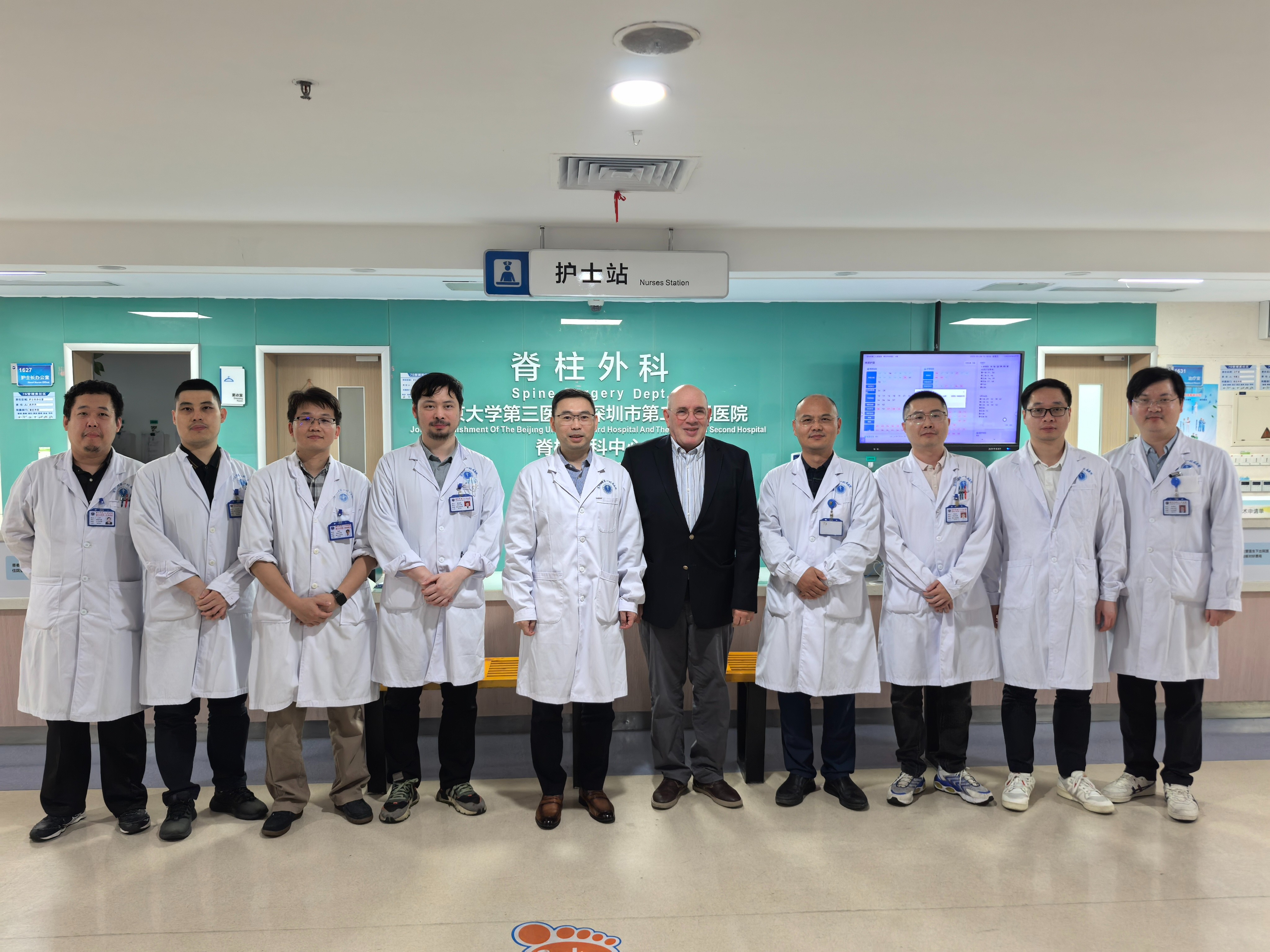-
News & Events

From March 24th to 28th , Dr. Rosenthal, the head of the Section of Spine Surgery in Regional Hospital Bad Homburg and former President of German Spine Society(DWG), visited the Shenzhen Second People’s Hospital as an international visiting professor and carried out a series of academic exchange activities in the hospital, including outpatient consultations, ward rounds, surgical guidance, surgical practice, internal lectures, discussions on complex cases, and public lecture, etc.
After all that waiting, the warm east breeze is blowing, spring has finally come. Everything is waking up from its winter sleep, the mountains look fresh after the rain, rivers are rising, and even the sun seems to glow brighter. That gentle spring wind carries the sweet smell of willow trees, soft against the face without any chill. On March 22, 2025, Dr. Rosenthal, the Head of the Section of Spine Surgery in Regional Hospital Bad Homburg and President of German Spine Society (DWG) in 2013, flied from Frankfurt to Shenzhen. He will visit the Shenzhen Second People's Hospital and Mianyang Orthopedic Hospital as a visiting professor. In June 2017, it was the first time he was invited by Gloryren to attend the Lingnan International Orthopaedics Conference and the 28th Orthopaedics Annual Meeting of Guangdong Medical Association as well as Gloryren's Midsummer Night's Welcome Banquet, since then we have worked closely with Dr. Rosenthal for 8 years. Over the past 8 years, Dr. Rosenthal has made ten trips to China’s Class III Grade A hospitals. He had visited Jiangmen People’s Hospital, the Third People’s Hospital of Henan Province, Guangdong Clifford Hospital, the Affiliated Hospital of Putian University and the Wuhan Orthopedics Hospital of Integrated Traditional Chinese and Western Medicine (The Affiliated Hospital of Wuhan Sports University) as a visiting professor; He had attended the Sino-Euro International Orthopaedics Summit(SEOS) in 2018 and 2019 as a special guest; He had invited Doctor FENG Jiawei, Chief Physician of the Dept of Orthopaedic II of Jiangmen People's Hospital, and Doctor ZHANG Yu, Director of the Dept of Spine Surgery of the Guangdong Second Traditional Chinese Medicine Hospital (Huangpu Hospital) as visiting fellows to study and exchange in his department; He have received Doctor SONG Kunfeng, Head of the minimally invasive cervical group of the MISS Department of the Third People's Hospital of Henan Province, Doctor Li from Yuyao, Zhejiang Province, and Doctor JIN Zizhuo from the Fuliang Jinshi Orthopedic Hospital as his MD students in Germany. He's a man of profound dedication. He is not only a master, but also a cherished friend to China’s hospitals and doctors. Without such dedication, no individual can make achievements, no one’s path of life can be easy, no soul can find its bearings, no character can become whole, no life can truly inspire others, no career can sustain excellence, and no existence can attain ultimate meaning.
On the morning of March 24th, Prof. ZHOU Wenyu, the head of Dept of Spine Surgery in the Shenzhen Second People’s Hospital, together with the spine surgery team, held a welcoming ceremony for Dr. Rosenthal, and both sides made a brief introduction of their hospitals.

Director ZHOU introduced briefly the Dept of Spine Surgery in the Shenzhen Second People’s Hospital. It is the first established spine surgery department in Shenzhen in 1997, with about 1500 spine surgeries annually, and focuses on spinal scoliosis, tumor, infection, complicated cervical vertebrate, minimally invasive spine surgery and pain management. The department has actively cooperated with other universities and hospitals at home and abroad for years, devoting to set up an example of comprehensive department integrating clinical treatment, teaching and research. Now it boasts as the top spine surgery department in Shenzhen.
Afterwards, Dr. Rosenthal introduced the spine surgery department of the Regional Hospital Bad Homburg, Germany. The department has three neurosurgeons and four orthopedic surgeons performing approximately 1,200 surgeries annually, treating conditions across the entire spine column, especially in thoracic spine. Renowned for outstanding advancements in thoracoscopic spine surgery, the department attracts patients from across Germany and Europe. Dr. Rosenthal said that he will share more experience in thoracoscopic spine surgery with Chinese colleagues in the coming days.
Director Zhou shared that he was deeply impressed by the inclusiveness and their emphasis on cultivating young doctors during his fellowship in Germany. He hoped that their department could send young doctors to study in Germany though Gloryren in the future.
After the welcoming ceremony, Dr. Rosenthal had further discussions on application of 3D microscope, treatment on cerebrospinal fluid leakage and postoperative rehabilitation with the team.
In the afternoon, led by Director ZHOU, Dr. Rosenthal visited the operating room and work well with the team in successfully removing T10 meningioma under a microscope.

Case Discussion and Ward rounds
On the morning of March 25th, Dr. Rosenthal participated in cases discussion with the spine surgery team upon arriving at the department. Among the reviewed cases was a particular complex patient: a three-month paralyzed patient with a huge thyroid metastasis on T1-2 levels, experiencing an operation failure before transferring to Shenzhen Second People’ hospital.
Evaluating from CT and MRI images after radiotherapy, Dr. Rosenthal said that the patient with huge tumor is likely to have huge blood loss during the operation which is life-threatening. He said that preoperative embolization must be done well. The team also agreed with Dr. Rosenthal that only when preoperative embolization is done successfully, will they consider to further perform tumor resection surgery for the patient.
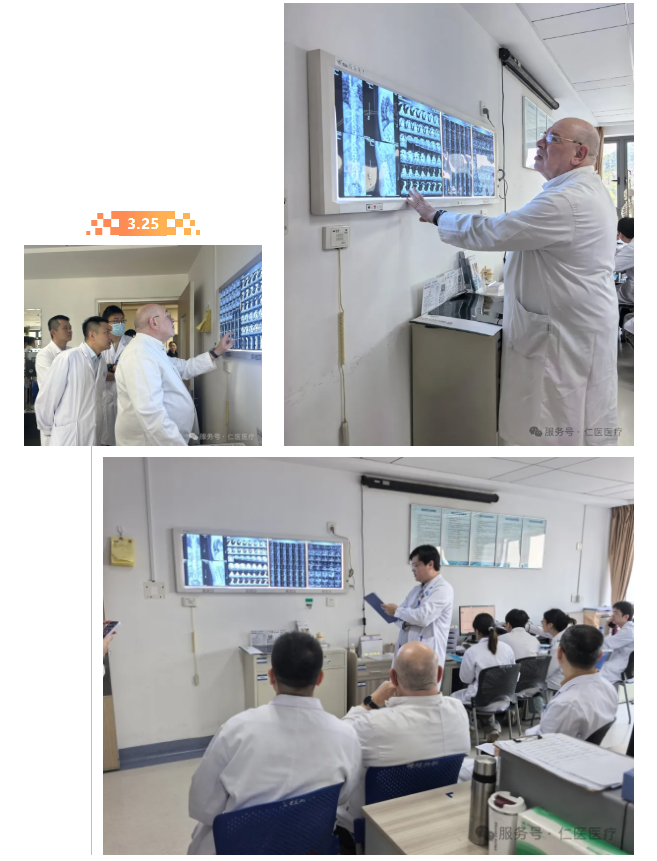
During the ward rounds, Dr. Roenthal warmly accessed the patient who had undergone T10 meningioma resection surgery yesterday. The patient felt good except minor pain in lower abdomen, then Dr. Rosenthal comforted her in Chinese that it takes time for the pain to relief gradually. Just be Patient.
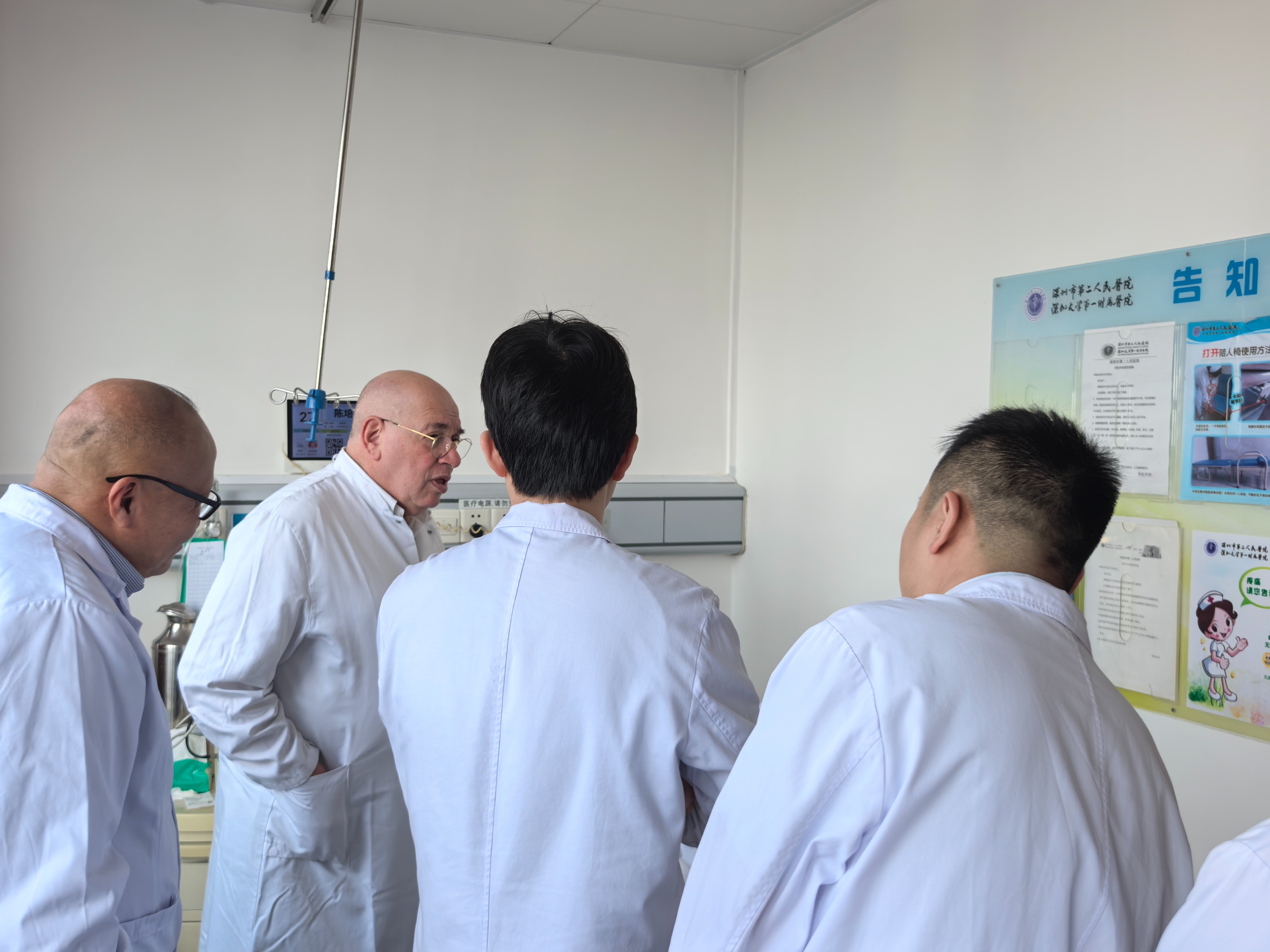
Then when Dr. Rosenthal visited the patient after ACCF, he noticed a difference between Germany and China when seeing a patient with a neck collar, as German doctors won’t suggest patients to wear neck collars after internal fixation. Instead, they would put themselves in the patients shoes to minimize their discomfort rather than merely care about the convenience for the doctors.

Internal lecture themed thoracic disc herniation
After the ward around, Dr. Rosenthal shared an internal lecture titled "Thoracic disc herniation. Symptoms, diagnostic steps and treatment algorythm" with the spine surgery team. He introduced the epidemiology of thoracic disc herniation, shared the common clinical symptoms of this pathology, and clearly illustrated the diagnosis and treatment flowchart of this pathology in their department.

Dr. Rosenthal said that although thoracic disc herniation is not common among spinal diseases, it is not as seldom as published, so spine surgeons still need to consider this possibility when making a diagnosis. He recommended that Chinese doctors could read a paper published by his team to better understand the clinical symptoms of thoracic disc herniation, which is "Symptom distribution and development in thoracic disc surgery - A retrospective case series of 664 patients".
At the end of the lecture, both parties had a heated discussion. Director GU Hongsheng shared his thoughts of this lecture and previous fellowship experience in Germany, highlighting that all colleagues at home should actively learned from advanced concepts, technologies and equipment from German hospitals. Regardless of the titles, medical staff should uphold the craftmanship as the German professors so as to keep up with the time.
Expert Outpatient Consultation in Spine Surgery
On March 26th, Dr. Rosenthal joined with Director ZENG Tenghui to see more than 30 patients in the expert outpatient consultation from 8 AM to 12 PM. With a meticulous attitude, he provided specialized solutions for different patients. For instance, Dr. Rosenthal won’t advice performing surgery for a patient with severe osteoporosis and old fracture. As her bone quality is not good, neither screws nor bone cement to support screws will enhance the spine stability. On the contrary, it will be more instable and the risks of spinal collapse/rod breakage will be high. Thus, he suggested the patient to go for conservative treatment. Moreover, drawing on rich clinical experience, Dr. Rosenthal also identified previously undetected pain caused by sacroiliac joint /thoracic spine, suggesting patient to have CT-scan and MRI for further diagnosis.

Dr. Rosenthal demonstrated rigorous clinical expertise in addressing patient concerns and also bring laughter into the busy and serious spine surgery outpatient clinic with his humor.
Internal Lecture in Spine Surgery
On the afternoon of March 26th, Dr. Rosenthal shared a lecture on “The anterolateral approach to the thoracic and lumbar spine” with the spine team. During the lecture, Dr. Rosenthal gradually dived deeper from graphically illustrating the load distribution between anterior and posterior of the spine to the concept of spine stability, from the distribution of vessels and nerve roots to the evolution of anterior spine surgery over the past 30 years. From his previous anterior spine surgeries, he explained the reasons and advantages to choose anterior or combine anterior-posterior approaches in some spine surgeries.
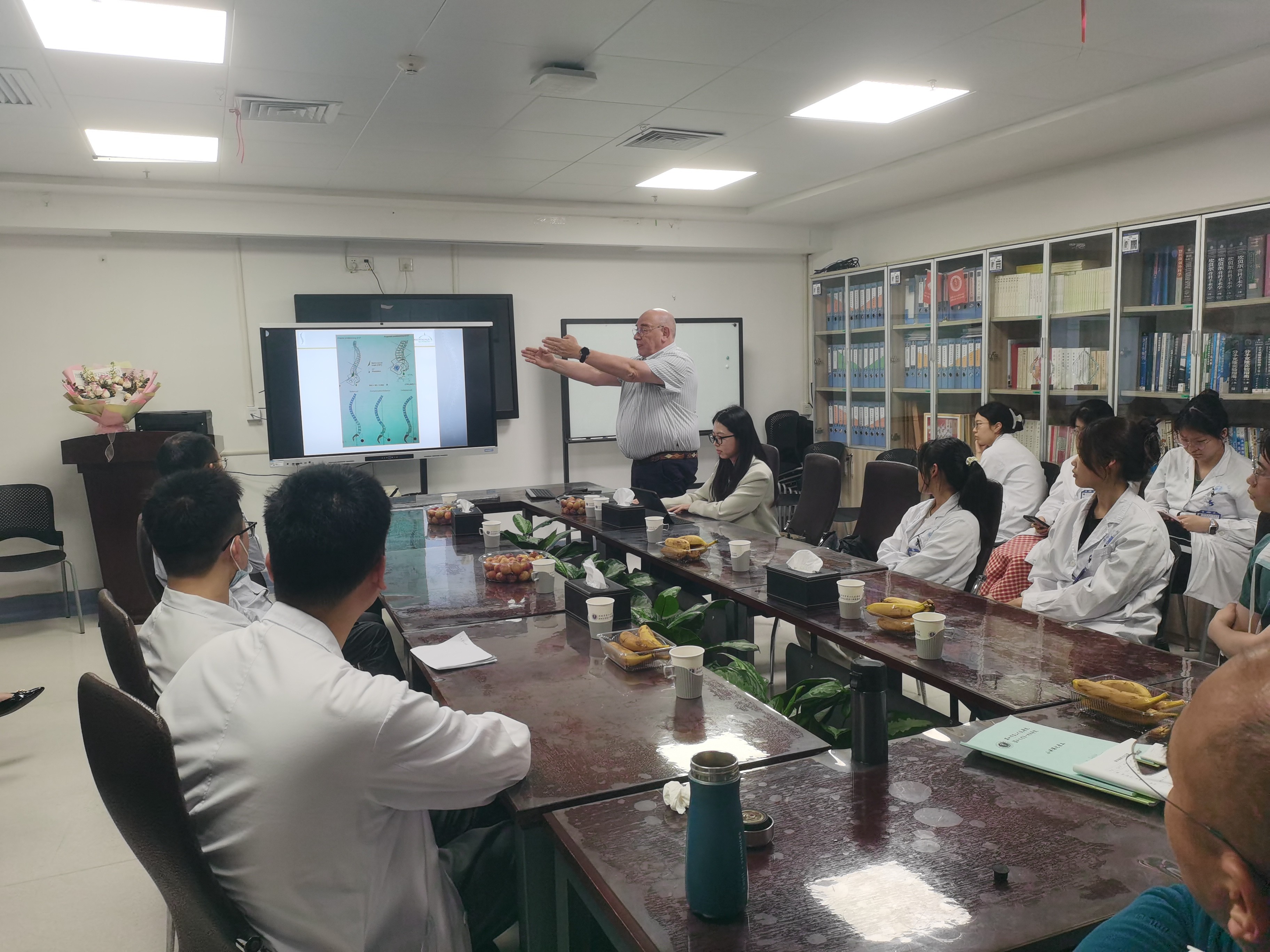
At the end of the lecture, Dr. Rosenthal emphasized the importance of innovation in medical field by quoting a saying from the founder of Ford- “If I’ve asked people what they wanted, they would have said faster horses.” In other words, innovation should focus on a leap in qualitative instead of merely quantity.
Special Lecture in Spine Surgery
On March 27th, Dr. Rosenthal shared a lecture titled “ A hybrid system - An option for less invasive approaches to the thoracolumbar”. He said that most of the complex spine diseases are treated with microsurgery, and due to the lack of space or maneuvrability, many doctors will directly turn to open surgery rather than endoscopic-assisted or microscopic surgery. Yet it should be noted that there is no omnipotent surgery equipment aligning well with all spine surgery. No matter endoscopic surgery or microscopic surgery, both of them have their own advantages and disadvantages.
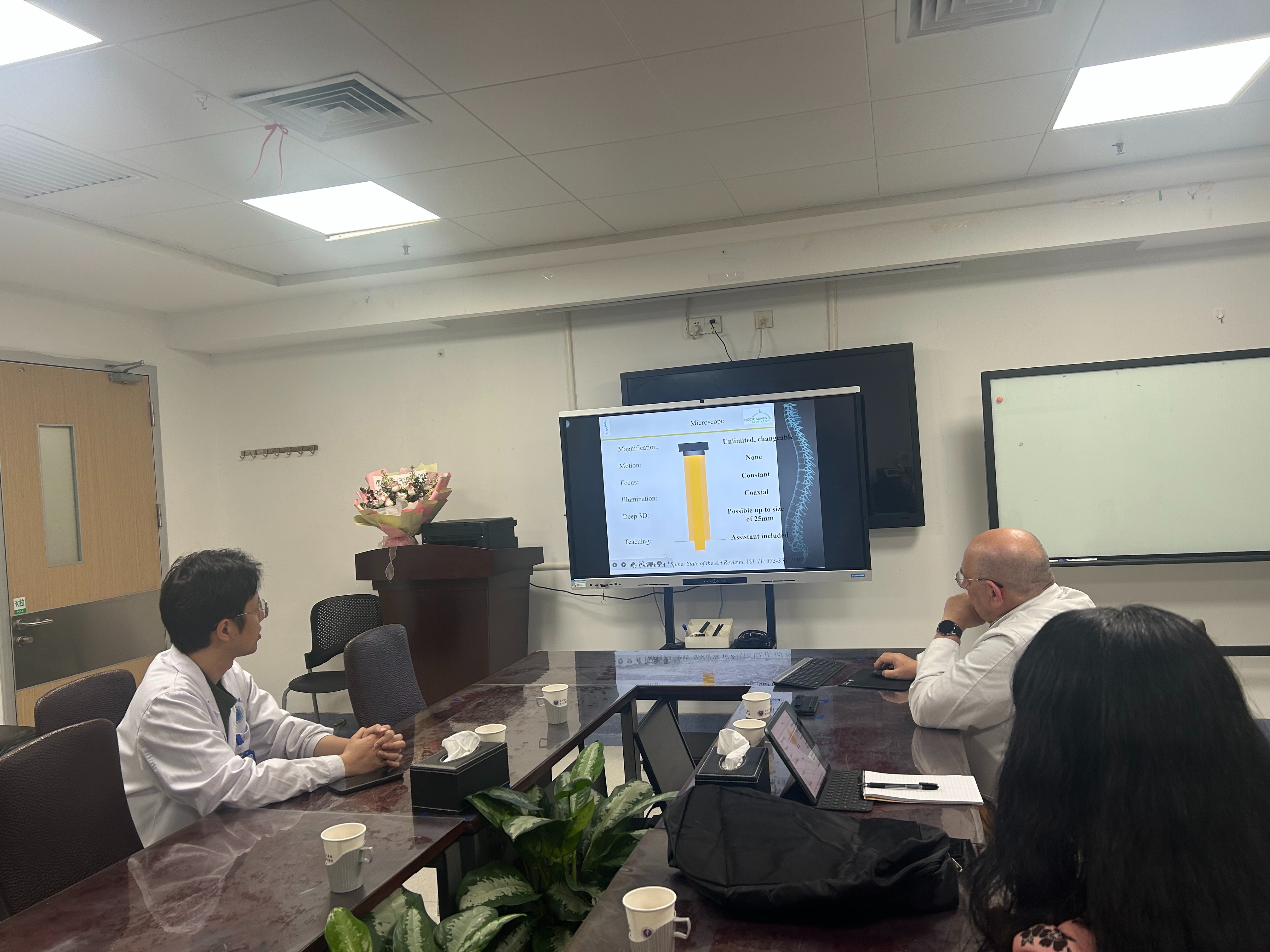
The key of choosing different surgery equipment lies in achieving the best visibility and illumination to observe the surroundings without enlarging the dissection. However, if neither endoscopy nor microscopy can well assist to perform a surgery, Dr. Rosenthal introduced a hybrid system-- VITOM which is an optimized microsurgery image system. This makes it possible for surgeons to perform microsurgical surgery in complex spinal diseases thus minimizing the approach related trauma, reducing the harm to healthy structures and achieving a better surgical outcome. Dr. Rosenthal showed how the VITOM system was used in clinical practice by showing a successful endoscopic-assisted thoracolumbar surgery via retroperitoneal extrapleural approach and several anterior surgeries for thoracolumbar fractures.
After the lecture, Dr. Rosenthal engaged with youth doctors on the spots to discuss issues such as how to choose between endoscopic- and microscopic-assisted spine surgery, how to choose between posterior and combined anterior-posterior for spine fractures patients and how to perform anterior surgery.
Master’s Public Lecture
March 28th was the last day of Dr. Rosenthal’s visit to the Shenzhen Second People’ s Hospital. He shared a lecture on “Therapeutic Algorithm on Thoracic Disc Herniation” and specifically illustrated how to perform anterior thoracoscopic surgery by playing multiple videos of performing thoracic disc herniation removal in this way. Dr. Rosenthal emphasized that thoracic disc herniation is not as seldom as published, so if the images of cervical and lumber spine are normal, surgeons should include a further diagnosis in thoracic spine.
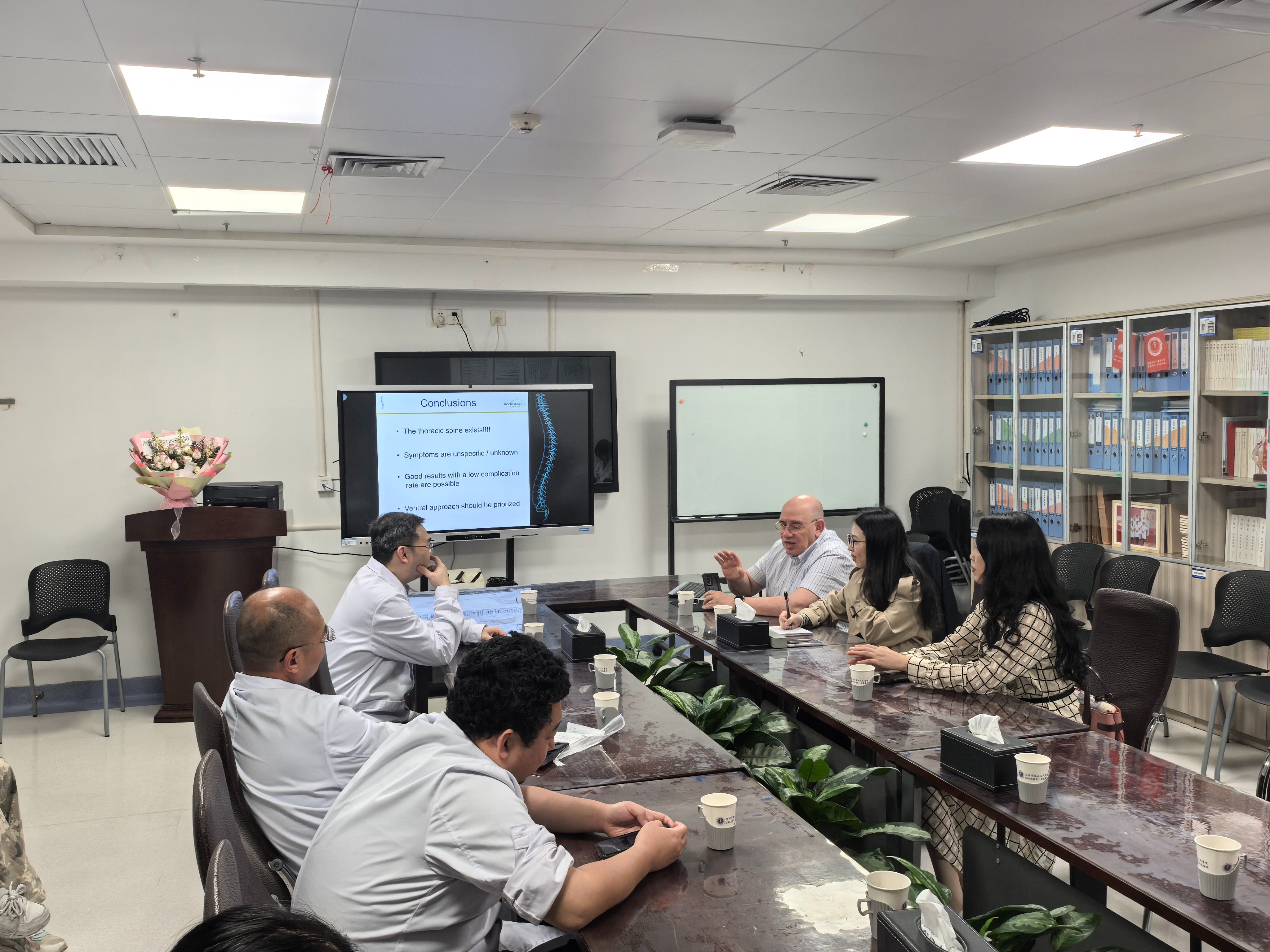
At the end of the lecture, Director ZHOU Wenyu and other young surgeons asked several related questions, for example, how to position before thoracoscopic surgery, how to treat intro-op dural tears, how to control intro-op blood losses, and how long should postoperative patients stay in hospital, all of which were answered by Dr. Rosenthal patiently. The team all had a new understanding of thoracic disc herniation after hearing the lecture and hoped to have the opportunity to visit Regional Hospital Bad Homburg to learn the thoracoscopic techniques on the spots in the future.
